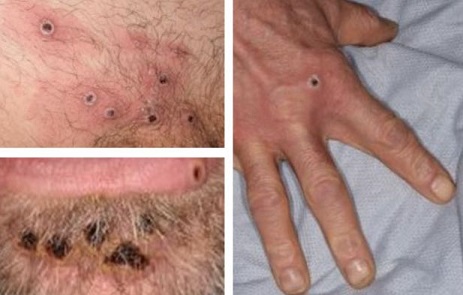BREAKING! Mpox virus can survive in scabs for months or even years, says U.S. Department of Homeland Security report!
Nikhil Prasad Fact checked by:Thailand Medical News Team Aug 19, 2024 8 months, 6 days, 9 hours, 42 minutes ago
MpoX News: A recently uncovered report from the U.S. Department of Homeland Security’s Science and Technology Directorate reveals alarming findings regarding the Mpox virus, also known as Monkeypox. The report, dated December 2023, indicates that the virus can survive in scabs for months or even years, posing a potential long-term threat in environments where contaminated materials are not properly sanitized.
 Mpox virus can survive in scabs for months or even years,
Mpox virus can survive in scabs for months or even years,
says U.S. Department of Homeland Security report
The Surprising Durability Mpox Virus In Scabs
Scabs, the protective crust that forms over wounds during the healing process, are more than just a temporary barrier against infection. These hardened clots of dried blood play a crucial role in wound healing by protecting underlying tissues from germs. However, not all wounds result in scabs, and the timeline for scabs to naturally fall off can vary from a few days to several weeks.
The durability of the Mpox virus in scabs becomes particularly concerning when considering their role as a potential reservoir for infectious viruses. Fallen scabs, if left in certain environments, can remain infectious for extended periods, as highlighted in the Homeland Security report.
The report also correlates with incidences reported in
Mpox News coverages in Africa where individuals with households that had deaths from Mpox infections reported family members getting infected months later despite having no or little contacts with others. The fallen scabs in the household could have contributed to their infections!
Mpox Virus: A Long-Lasting Threat
Poxviruses, which include the variola and vaccinia viruses, are known for their ability to remain infectious in sloughed scabs and unwashed linens for extended periods - sometimes lasting months to years. The Mpox virus (MPXV), a member of the orthopoxvirus family, appears to share similar resilience.
The report outlines that while the stability of MPXV might be slightly less than that of other poxviruses, it is still capable of persisting for long periods in certain conditions. For example, viral DNA from MPXV lesions has been shown to remain stable for days in patient samples such as blood, urine, and skin lesions. The report also noted that live MPXV was recovered from various surfaces in a patient’s home even 15 days after the patient was hospitalized.
Environmental Stability of Mpox Virus
The Mpox virus exhibits remarkable stability in different environments, raising concerns about its potential to remain a public health threat if not adequately addressed. The Homeland Security report details several key findings:
-Resistance to Desiccation: MPXV is relatively resistant to drying out, both in hot and cold conditions. Even after repeated freezing and thawing, the virus exhibited only a minor loss in infectivity.
-
Longevity on Surfaces: Contaminated materials, including clothes, paper, and dust, may remain infectious for years if not properly disinfected. The virus was also found to persist on surfaces such as gauze and food items stored at 4°C for up to two weeks.
-Impact of Temperature: The report highlights that while storage at colder temperatures (-20°C and -70°C) resulted in a significant reduction in viral viability over time, the virus still managed to survive for extended periods. In contrast, storage at 4°C maintained the virus’s infectivity for several months.
What This Means for Public Health
The findings of this report underscore the importance of understanding the long-term stability of the Mpox virus in various environments. The ability of the virus to survive in scabs and on surfaces for extended periods highlights the need for stringent hygiene and disinfection protocols, particularly in healthcare settings and areas where infected individuals have been present.
Several critical questions remain, such as the exact duration of the virus’s viability in dried scabs on patients and whether MPXV follows the same stability patterns as other orthopoxviruses. Further research is needed to answer these questions and develop effective strategies to mitigate the risks associated with this resilient virus.
In light of these findings, public health officials and healthcare providers must remain vigilant in monitoring and controlling the spread of Mpox.
The U.S. Department Of Homeland Security’s report on Mpox can be found here.
https://www.dhs.gov/sites/default/files/2023-12/23_1220_st_monkeypox_MQL_cleared_for_public_release.pdf
Please do not share this story without providing links to us. We have the date and time stamp of when this article was published and anyone simply posting the DHS link with reference to the durability of the Mpox virus in scabs without sharing our link will be subject to legal action.
For the latest
Mpox News, Keep on logging to Thailand Medical News.
Read Also:
https://www.thailandmedical.news/news/mpox-virus-shows-prolonged-surface-survival-especially-at-lower-temperatures
https://www.thailandmedical.news/news/monkeypox-mpox-can-cause-a-variety-of-eye-issues-that-can-result-in-vision-loss
